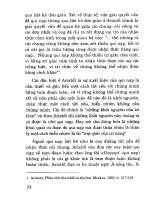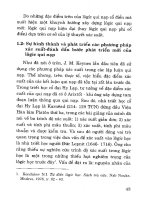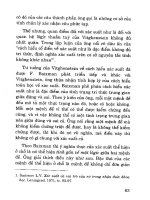VAI TRÕ CỦA PROCALCITONIN TRONG NHẬN ĐỊNH DẤU HIỆU NHIỄM TRÙNG VÀ HƯỚNG DẪN SỬ DỤNG KHÁNG SINH
Bạn đang xem bản rút gọn của tài liệu. Xem và tải ngay bản đầy đủ của tài liệu tại đây (1.54 MB, 39 trang )
<span class='text_page_counter'>(1)</span><div class='page_container' data-page=1>
<b>Procalcitonin to Predict Septic Shock </b>
<b>& Guide Antibiotic Therapy </b>
William T. McGee, M.D. MHA, FCCM, FCCP
Critical Care Medicine
Associate Professor of Medicine and Surgery
University of Massachusetts
759 Chestnut Street, Springfield, MA 01199
Tel: 413-794-5439 | Fax: 413-794-3987
</div>
<span class='text_page_counter'>(2)</span><div class='page_container' data-page=2>
<b>2</b>
<b>2</b>
<b>Role of PCT in sepsis</b>
<b>Alternative (non cytokine) pathway during sepsis: ‘Hormokine’</b>
<b>Bacterial toxins </b>
(gran +/gram-) and cytokines stimulate
production of Procalcitonin in all parenchymal cells
This process can be attenuated or
<i><b>blocked during viral </b></i>
<i><b>infection by interferons</b></i>
.
</div>
<span class='text_page_counter'>(3)</span><div class='page_container' data-page=3>
<b>3</b>
<b>3</b>
<b>Antibiotic misuse, inappropriate initiation and prolonged use</b>
<b>Safety risk to patients due to rise of antibiotic resistance</b>
<b>2 million illnesses and ~23,000 deaths per year in U.S.*</b>
<b>SERIOUS AND GROWING THREAT TO U.S. </b>
<b>AND GLOBAL PUBLIC HEALTH</b>
</div>
<span class='text_page_counter'>(4)</span><div class='page_container' data-page=4>
<b>4</b>
<b>4</b>
<b>Bacterial cultures can take 2-3 days </b>
<b>to perform</b>
<b>May have low sensitivity</b>
<b>Faster, more accurate indicators </b>
<b>of infection needed to make </b>
<b>critical antibiotic decisions</b>
</div>
<span class='text_page_counter'>(5)</span><div class='page_container' data-page=5>
<b>5</b>
<b>5</b>
<b>Out of 69M people who are given antibiotics for respiratory issues, </b>
<b>annually in the U.S.</b>
<b>50% OF ANTIBIOTICS PRESCRIBED FOR</b>
<b>ACUTE RESPIRATORY CONDITIONS ARE </b>
<b>UNNECESSARY</b>
<b>34.3 Million</b>
Get antibiotics unnecessarily
<b>34.6 Million</b>
Who need antibiotics get them
</div>
<span class='text_page_counter'>(6)</span><div class='page_container' data-page=6>
<b>6</b>
<b>6</b>
<b>Misuse associated with drug toxicity, increased antibiotic </b>
<b>resistance, and collateral damage </b>
<b>Increased drug-resistant infections result in:</b>
• More-serious illness or disability
• Higher death rate
• Prolonged recovery
• More-frequent or longer hospitalizations
<b>Two common syndromes: Lower respiratory tract infection and </b>
<b>sepsis</b>
</div>
<span class='text_page_counter'>(7)</span><div class='page_container' data-page=7>
<b>7</b>
<b>7</b>
<b>Procalcitonin</b>
How can we use this cellular signal of infection
in the management of both septic and non
septic patients
<sub>Goals</sub>
Provide antibiotic therapy to pts who need it as soon
as possible
Avoid antibiotic prescription to those without infection
Do both with a strong likelihood of being correct, at
</div>
<span class='text_page_counter'>(8)</span><div class='page_container' data-page=8>
<b>PCT kinetics provide important information on </b>
<b>prognosis of sepsis patients</b>
•
PCT levels, can be observed within 3-6 hours after an
infection with a peak - up to 1000 ng/ml - after 6-12 hrs.
Half-life: ~24hrs
•
<i><b><sub>Specific to bacterial origin</sub></b></i>
<sub>of infection and reflects the </sub>
</div>
<span class='text_page_counter'>(9)</span><div class='page_container' data-page=9>
<b>9</b>
Simon L. et al. Clin Infect Dis. 2004; 39:206-217.
<b>Adding PCT results to clinical assessment improves the </b>
<b>accuracy of the early clinical diagnosis of sepsis</b>
•
<b>PCT levels accurately differentiate sepsis from noninfectious </b>
<b>inflammation*</b>
•
<b>PCT is the best marker for differentiating patients with sepsis from </b>
<b>those with systemic inflammatory reaction not related to infection</b>
</div>
<span class='text_page_counter'>(10)</span><div class='page_container' data-page=10>
<b>10</b>
<b>10</b>
<b>PCT PROPERTIES FAVORABLE FOR ANTIBIOTIC </b>
<b>DECISION MAKING</b>
<i>*Nosocomial infection resulting from a single contaminated infusion at time 0</i>
<i>Brunkhorst et al. Intensive Care Med 1998;24:888-9</i>
</div>
<span class='text_page_counter'>(11)</span><div class='page_container' data-page=11>
<b>11</b>
<b>11</b>
<b>PCT LEVELS CORRELATE WITH DISEASE </b>
<b>SEVERITY</b>
</div>
<span class='text_page_counter'>(12)</span><div class='page_container' data-page=12>
<b>12</b>
<b>12</b>
<b>NPV = probability condition is absent given negative test</b>
<b>PCT LEVELS HAVE A HIGH NEGATIVE </b>
<b>PREDICTIVE VALUE IN LRTI</b>
<i>a<sub>Rodriguez et al. J Infect 2016;72:143-51</sub></i>
<i>b<sub>Stolz et al. Swiss Med Wkly 2006;136:434-40</sub></i>
<i>Data on file at bioMérieux Inc.</i>
<b>Endpoint </b>
<b>(Prevalence)</b> <b>Sensitivity</b> <b>Specificity </b> <b>PPV</b> <b>NPV</b>
<b>Rodrigueza</b>a
Confirmed
bacterial
co-infection
(20%)
90% 31% 25% 92%
<b>Stolz</b>b
Need for
antibiotics
(24%)
</div>
<span class='text_page_counter'>(13)</span><div class='page_container' data-page=13>
<b>Typical time course of PCT: successful tx</b>
<b>13</b>
</div>
<span class='text_page_counter'>(14)</span><div class='page_container' data-page=14>
<b>14</b>
<b>Effect of Procalcitonin-Based Guidelines</b>
<b>vs. Standard Guidelines on Antibiotic Use</b>
<b>in Lower Respiratory Tract Infections:</b>
<b>The ProHOSP Randomized Controlled Trial</b>
Philipp Schuetz, MD; Mirjam Christ-Crain, MD;
Robert Thomann, MD; Claudine Falconnier, MD;
Marcel Wolbers, PhD; Isabelle Widmer, MD;
Stefanie Neidert, MD; Thomas Fricker, MD;
Claudine Blum, MD; Ursula Schild, RN;
Katharina Regez, RN; Ronald Schoenenberger, MD;
Christoph Henzen, MD; Thomas Bregenzer, MD;
Claus Hoess, MD; Martin Krause, MD; Heiner C. Bucher, MD;
Werner Zimmerli, MD; Beat Mueller, MD
<i>Journal of the American Medical Association. </i>
</div>
<span class='text_page_counter'>(15)</span><div class='page_container' data-page=15>
<b>15</b>
<b>Overview</b>
•
<b>Unnecessary antibiotic use</b>
•
<b>Contributes to increasing bacterial resistance</b>
•
<b>Increases medical costs and the risks </b>
<b>of drug-related adverse events</b>
<b>Schuetz P et al. </b><i><b>J Am Med Assoc</b></i><b>. 2009;302(10):1059-66.</b>
•
<b>Lower respiratory tract infections (LTRI)</b>
–
<b>Most frequent indication for antibiotic prescriptions</b>
<b>in the Northwestern hemisphere</b>
–
<b>75% of patients are treated with antibiotics</b>
–
<b>Predominantly viral origin of infection</b>
•
<b>Procalcitonin (PCT) algorithm </b>
</div>
<span class='text_page_counter'>(16)</span><div class='page_container' data-page=16>
<b>16</b>
Objective
<b>Examine whether a PCT algorithm can </b>
<b>reduce antibiotic exposure without increasing </b>
<b>the risk for serious adverse outcomes.</b>
<b>Schuetz P et al. </b><i><b>J Am Med Assoc</b></i><b>. 2009;302(10):1059-66.</b>
</div>
<span class='text_page_counter'>(17)</span><div class='page_container' data-page=17>
<b>17</b>
<b>Multicenter, noninferiority, randomized controlled trial</b>
<b>Schuetz P et al. </b><i><b>J Am Med Assoc</b></i><b>. 2009;302(10):1059-66.</b>
<b>Study Design</b>
•
<b>Main Outcome Measures</b>
–
<b>Composite adverse outcomes of death, intensive care </b>
<b>unit admission, disease-specific complications, </b>
<b>or recurrent infection within 30 days</b>
–
<b>Antibiotic exposure and adverse effects from antibiotics</b>
•
<b>Patients </b>
–
<b>Randomized to administration of antibiotics based </b>
<b>on PCT algorithm</b>
–
<b>Cutoff ranges for initiating or stopping antibiotics </b>
<b>(PCT group) or standard guidelines (control) </b>
</div>
<span class='text_page_counter'>(18)</span><div class='page_container' data-page=18>
<b>18</b>
<b>Flow Diagram of Patients in Trial</b>
<b>Schuetz P et al. </b><i><b>J Am Med Assoc</b></i><b>. 2009;302(10):1059-66.</b>
<b>687 Randomized to </b>
<b>Receive Antibiotics Based </b>
<b>on PCT Algorithm</b>
<b>694 Randomized to </b>
<b>Receive Antibiotics Based </b>
<b>on Standard Guidelines</b>
<b>16 Withdrew Informed Consent</b>
<b>1 Lost to Follow-up</b>
<b>34 Died</b>
<b>6 Withdrew Informed Consent</b>
<b>0 Lost to Follow-up</b>
<b>33 Died</b>
<b>636 Completed 30-d Interview</b> <b>655 Completed 30-d Interview</b>
<b>671 Included in Primary Analysis</b>
<b>16 Excluded </b>
<b>(Withdrew Informed Consent)</b>
<b>688 Included in Primary Analysis</b>
<b>6 Excluded </b>
</div>
<span class='text_page_counter'>(19)</span><div class='page_container' data-page=19>
<b>Results</b>
<b>No difference </b>
:
<b>death, intensive care </b>
<b>unit admission, disease-specific </b>
<b>complications, </b>
<b>or recurrent infection within 30 days </b>
</div>
<span class='text_page_counter'>(20)</span><div class='page_container' data-page=20>
<b>20</b>
<b>SIMILAR RATES OF MORTALITY IN LRTI </b>
<b>PATIENT-LEVEL META-ANALYSIS</b>
</div>
<span class='text_page_counter'>(21)</span><div class='page_container' data-page=21>
<b>21</b>
<b>0</b>
<b>Schuetz P et al. </b><i><b>J Am Med Assoc</b></i><b>. 2009;302(10):1059-66.</b>
<b>Antibiotic Exposure in Patients </b>
<b>Receiving Antibiotic Therapy</b>
<b>All Patients </b>
<b>(n = 1359)</b>
<b>Community-acquired Pneumonia </b>
<b>(n = 925)</b>
<b>Pati</b>
<b>en</b>
<b>ts </b>
<b>R</b>
<b>eceiv</b>
<b>in</b>
<b>g</b>
<b>A</b>
<b>n</b>
<b>ti</b>
<b>b</b>
<b>io</b>
<b>ti</b>
<b>c </b>
<b>T</b>
<b>h</b>
<b>er</b>
<b>ap</b>
<b>y,</b>
<b> %</b>
<b>20</b>
<b>40</b>
<b>60</b>
<b>80</b>
<b>100</b>
<b>Time After Study Inclusion, d</b> <b>Time After Study Inclusion, d</b>
<b>0 1 2 5 7 9 11 >13</b>
<b>No. of Patients</b>
<b>PCT 506 484 410 306 207 138 72 46</b>
<b>Control 603 589 562 516 420 324 157 100</b>
<b>417 410 359 272 161 126 64 41</b>
<b>461 453 444 428 361 292 146 91</b>
<b>0 1 2 5 7 9 11 >13</b>
<b>PCT</b>
</div>
<span class='text_page_counter'>(22)</span><div class='page_container' data-page=22>
<b>22</b>
<b>Schuetz P et al. </b><i><b>J Am Med Assoc</b></i><b>. 2009;302(10):1059-66.</b>
<b>0</b>
<b>Pati</b>
<b>en</b>
<b>ts </b>
<b>R</b>
<b>eceiv</b>
<b>in</b>
<b>g</b>
<b>A</b>
<b>n</b>
<b>ti</b>
<b>b</b>
<b>io</b>
<b>ti</b>
<b>c </b>
<b>T</b>
<b>h</b>
<b>er</b>
<b>ap</b>
<b>y,</b>
<b> %</b>
<b>20</b>
<b>40</b>
<b>60</b>
<b>80</b>
<b>100</b>
<b>Time After Study Inclusion, d</b>
<b>0 1 2 5 7 9 11 >13</b>
<b>Time After Study Inclusion, d</b>
<b>0 1 2 5 7 9 11 >13</b>
<b>Exacerbation of COPD </b>
<b>(n = 228)</b>
<b>Acute Bronchitis </b>
<b>(n = 151)</b>
<b>No. of Patients</b>
<b>PCT 56 47 30 23 16 6 4 2</b>
<b>Control 79 78 67 56 40 20 5 4</b>
<b>16 11 9 3 3 1 1 1</b>
<b>41 38 35 19 8 3 0 0 </b>
<b>PCT: Procalcitoin</b>
<b>COPD: Chronic Obstructive Pulmonary Disease</b>
<b>PCT</b>
<b>Control</b>
</div>
<span class='text_page_counter'>(23)</span><div class='page_container' data-page=23>
<b>23</b>
<b>< 0.1 μg/l</b>
<b>NO antibiotics !</b>
<b>0.1 - 0.25 μg/l</b> <b>>0.25 – 0.5 μg/l</b> <b>>0.5 μg/l</b>
<b>No antibiotics</b> <b>Antibiotics yes</b> <b>Antibiotics YES !</b>
<b>Control PCT after 6-24 hours</b>
<b>Initial antibiotics can be considered in case of:</b>
- <b>Respiratory or hemodynamic instability</b>
- <b>Life-threatening comorbidity</b>
- <b>Need for ICU admission</b>
- <b>PCT < 0.1 μg/l: </b> <b>CAP with PSI V or CURB65 >3,</b>
<b>COPD with GOLD IV</b>
- <b>PCT < 0.25 μg/l: CAP with PSI ≥IV or CURB65 >2,</b>
<b>COPD with GOLD > III</b>
- <b>Localised infection (abscess, empyema), </b>
<b>L.pneumophilia</b>
- <b>Compromised host defense (e.g. </b>
<b>immuno-suppression other than corticosteroids)</b>
- <b>Concomitant infection in need of antibiotics</b>
<b>Bacterial etiology </b>
<b>very unlikely</b>
<b>Bacterial etiology </b>
<b>unlikely</b>
<b>Bacterial etiology </b>
<b>likely</b>
<b>Bacterial etiology </b>
<b>very likely</b>
<b>Procalcitonin (PCT) algorithm for stewardship of antibiotic therapy in patients with LRTI </b>
<b>Consider the course of PCT</b>
<b>If antibiotics are initiated:</b>
- <b>Repeated measurement of PCT on days 3, 5, 7</b>
- <b>Stop antibiotics using the same cut offs above</b>
- <b>If initial PCT levels are >5-10 μg/l, then </b>
<b>stop when 80-90% decrease of peak PCT</b>
- <b>If initial PCT remains high, consider treatment </b>
<b>failure (e.g. resistant strain, empyema, ARDS)</b>
- <b>Outpatients: duration of antibiotics according </b>
<b>to the last PCT result:</b>
- <b>>0.25-0.5 μg/l: 3 days</b>
- <b>>0.5 - 1.0 μg/l: 5 days</b>
- <b>>1.0 μg/l:</b> <b>7 days</b>
<b>PCT: procalcitonin, CAP: community-acquired pneumonia, PSI: pneumonia severity index, </b>
</div>
<span class='text_page_counter'>(24)</span><div class='page_container' data-page=24>
<b>24</b>
<b>Conclusions</b>
<b>An algorithm with PCT cutoff ranges was noninferior</b>
<b>to clinical guidelines in terms of adverse outcomes </b>
<b>death, intensive care </b>
<b>unit admission, disease-specific complications, </b>
<b>or recurrent infection within 30 days </b>
<b>Reduced antibiotic exposure</b>
<b>Reduced associated adverse effects</b>
<b>In countries with higher antibiotic prescription </b>
<b>rates PCT guidance may have clinical and </b>
<b>public health implications</b>
</div>
<span class='text_page_counter'>(25)</span><div class='page_container' data-page=25>
<b>25</b>
<b>A GLOBAL PUBLIC HEALTH EMERGENCY</b>
</div>
<span class='text_page_counter'>(26)</span><div class='page_container' data-page=26>
<b>Additional Results </b>
Predictive value of baseline
PCT to determine + culture
(blood, urine, respiratory)
<b>Positive vs. Negative culture</b>
<b>9.8ng/mL [1.7-41.3] vs. </b>
<b>3.3ng/mL[0.6-15.8] p<0.001</b>
61% of cultures were positive
Predictive value of baseline
PCT to determine sepsis
severity
<b>Septic shock vs. Sepsis</b>
<b>13.6ng/mL [2.7-55.2] vs. </b>
<b>3.6[0.5-15.6], p<0.001</b>
</div>
<span class='text_page_counter'>(27)</span><div class='page_container' data-page=27>
<b>Additional Results </b>
•
<b>Baseline PCT was similar in survivors and non-survivors </b>
<b>however there was a significantly faster decline overtime in the </b>
<b>serial PCT levels in survivors </b>
•
<b>Baseline cut off of ≤ 3ng/mL excluded positive blood culture </b>
<b>with a sensitivity of 90% (95% CI, 82-89) and a NPV of 96% (95% </b>
<b>CI, 93-99)</b>
•
<b>Baseline cut off of ≤ 0.1ng/mL excluded positive culture in the </b>
<b>first 72h with a sensitivity of 100% and NPV of 100%</b>
</div>
<span class='text_page_counter'>(28)</span><div class='page_container' data-page=28></div>
<span class='text_page_counter'>(29)</span><div class='page_container' data-page=29>
<b>Mort</b>
</div>
<span class='text_page_counter'>(30)</span><div class='page_container' data-page=30>
<b>30</b>
<b>Case 1 </b>
78 y/o female found unresponsive at home by
</div>
<span class='text_page_counter'>(31)</span><div class='page_container' data-page=31>
<b>31</b>
<b>Case 1 </b>
78 y/o female found unresponsive at home by family. Noted to be in
respiratory distress. Intubated in the ED for apnea. Prior h/o DM, HTN, UTI,
AV block, pacemaker, mild dimentia and AKA. In ED WBC 14.6 with 31
bands, AG 14, BUN 53, PCT 2.7. Patient had been receiving TPN via
porto-cath at home.
<b>31</b>
<b>0</b>
<b>Ng</b>
<b>/mL</b>
<b>5</b>
<b>10</b>
<b>15</b>
<b>20</b>
<b>100</b>
<b>Days</b>
<b>0 </b> <b>1 </b> <b>2 </b> <b>3 </b> <b>4 </b> <b>5 </b> <b>6</b>
</div>
<span class='text_page_counter'>(32)</span><div class='page_container' data-page=32>
<b>32</b>
<b>Case 1 </b>
<b>32</b>
<b>0</b>
<b>Ng</b>
<b>/mL</b>
<b>5</b>
<b>10</b>
<b>15</b>
<b>20</b>
<b>100</b>
<b>Days</b>
<b>0 </b> <b>1 </b> <b>2 </b> <b>3 </b> <b>4 </b> <b>5 </b> <b>6</b>
<b>PCT</b>
<b>WBC</b>
<b>Bands</b>
<b>Tmax</b>
78 y/o female found unresponsive at home by family. Noted to be in
respiratory distress. Intubated in the ED for apnea. Prior h/o DM, HTN, UTI,
AV block, pacemaker, mild dimentia and AKA. In ED WBC 14.6 with 31
</div>
<span class='text_page_counter'>(33)</span><div class='page_container' data-page=33>
<b>33</b>
<b>Case 1 </b>
<b>33</b>
<b>0</b>
<b>Ng</b>
<b>/mL</b>
<b>5</b>
<b>10</b>
<b>15</b>
<b>20</b>
<b>100</b>
<b>Days</b>
<b>0 </b> <b>1 </b> <b>2 </b> <b>3 </b> <b>4 </b> <b>5 </b> <b>6</b>
<b>PCT</b>
<b>WBC</b>
<b>Bands</b>
<b>Tmax</b>
78 y/o female found unresponsive at home by family. Noted to be in
respiratory distress. Intubated in the ED for apnea. Prior h/o DM, HTN, UTI,
AV block, pacemaker, mild dimentia and AKA. In ED WBC 14.6 with 31
</div>
<span class='text_page_counter'>(34)</span><div class='page_container' data-page=34>
<b>34</b>
<b>Case 1 </b>
<b>34</b>
<b>0</b>
<b>Ng</b>
<b>/mL</b>
<b>5</b>
<b>10</b>
<b>15</b>
<b>20</b>
<b>100</b>
<b>Days</b>
<b>0 </b> <b>1 </b> <b>2 </b> <b>3 </b> <b>4 </b> <b>5 </b> <b>6</b>
<b>PCT</b>
<b>WBC</b>
<b>Bands</b>
<b>Tmax</b>
78 y/o female found unresponsive at home by family. Noted to be in
respiratory distress. Intubated in the ED for apnea. Prior h/o DM, HTN, UTI,
AV block, pacemaker, mild dimentia and AKA. In ED WBC 14.6 with 31
bands, AG 14, BUN 53, PCT 2.7. Patient had been receiving TPN via
porto-cath at home.
</div>
<span class='text_page_counter'>(35)</span><div class='page_container' data-page=35>
<b>35</b>
<b>Case 1 </b>
<b>35</b>
<b>0</b>
<b>Ng</b>
<b>/mL</b>
<b>5</b>
<b>10</b>
<b>15</b>
<b>20</b>
<b>100</b>
<b>Days</b>
<b>0 </b> <b>1 </b> <b>2 </b> <b>3 </b> <b>4 </b> <b>5 </b> <b>6</b>
<b>PCT</b>
<b>WBC</b>
<b>Bands</b>
<b>Tmax</b>
78 y/o female found unresponsive at home by family. Noted to be in
respiratory distress. Intubated in the ED for apnea. Prior h/o DM, HTN, UTI,
AV block, pacemaker, mild dimentia and AKA. In ED WBC 14.6 with 31
bands, AG 14, BUN 53, PCT 2.7. Patient had been receiving TPN via
porto-cath at home.
</div>
<span class='text_page_counter'>(36)</span><div class='page_container' data-page=36>
<b>36</b>
<b>Case 1 </b>
<b>36</b>
<b>0</b>
<b>Ng</b>
<b>/mL</b>
<b>5</b>
<b>10</b>
<b>15</b>
<b>20</b>
<b>100</b>
<b>Days</b>
<b>0 </b> <b>1 </b> <b>2 </b> <b>3 </b> <b>4 </b> <b>5 </b> <b>6</b>
<b>PCT</b>
<b>WBC</b>
<b>Bands</b>
<b>Tmax</b>
78 y/o female found unresponsive at home by family. Noted to be in
respiratory distress. Intubated in the ED for apnea. Prior h/o DM, HTN, UTI,
AV block, pacemaker, mild dimentia and AKA. In ED WBC 14.6 with 31
bands, AG 14, BUN 53, PCT 2.7. Patient had been receiving TPN via
porto-cath at home.
</div>
<span class='text_page_counter'>(37)</span><div class='page_container' data-page=37>
<b>37</b>
<b>Case 2</b>
68 y/o male with h/o CHF, COPD, CAD
previously hospitlaized two months ago for
exacerbation of COPD. Presents with difficulty
breathing, SOB. No chest pain, but has cough
with clear to yellow sputum. ABG in ED
</div>
<span class='text_page_counter'>(38)</span><div class='page_container' data-page=38>
<b>38</b>
<b>Case 2 </b>
68 y/o male with h/o CHF, COPD, CAD previously hospitlaized two months
ago for exacerbation of COPD. Presents with difficulty breathing, SOB. No
chest pain, but has cough with clear to yellow sputum. ABG in ED
7.11/76/91 BNP 1301 Trop < .03 WBC 18,000, 0 Bands.
<b>38</b>
<b>0</b>
<b>Ng</b>
<b>/mL</b>
<b>5</b>
<b>10</b>
<b>15</b>
<b>20</b>
<b>100</b>
<b>Days</b>
<b>0 </b> <b>1 </b> <b>2 </b> <b>3 </b> <b>4 </b> <b>5 </b> <b>6</b>
</div>
<span class='text_page_counter'>(39)</span><div class='page_container' data-page=39>
<b>39</b>
<b>Case 2 </b>
68 y/o male with h/o CHF, COPD, CAD previously hospitlaized two months
ago for exacerbation of COPD. Presents with difficulty breathing, SOB. No
chest pain, but has cough with clear to yellow sputum. ABG in ED
7.11/76/91 BNP 1301 Trop < .03 WBC 18,000, 0 Bands.
<b>39</b>
<b>0</b>
<b>Ng</b>
<b>/mL</b>
<b>5</b>
<b>10</b>
<b>15</b>
<b>20</b>
<b>100</b>
<b>Days</b>
<b>0 </b> <b>1 </b> <b>2 </b> <b>3 </b> <b>4 </b> <b>5 </b> <b>6</b>
</div>
<!--links-->









